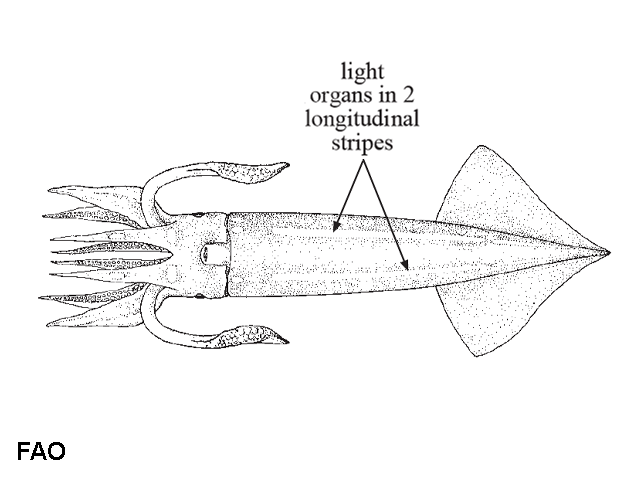| Ommastrephidae (flying squids and arrow squids), subfamily: Ommastrephinae |
| 22.7 cm ML (male/unsexed); 180 cm ML (female); max.weight: 235.0 g |
|
pelagic; marine; depth range 0 - 1300 m |
| Circumglobal in tropical to temperate waters. |
|
|
| Geographical variability of size at maturity and size morphology is pronounced. Maximum size and size at maturity increases from the low latitudes to the high latitudes (Ref. 97142). Incidentally caught by jigs (Ref. 275). True bi-peripheral oceanic species. Epipelagic and upper mesopelagic; distributed from the surface to 400 m. Inhabits open waters, mostly over great depths of more than 200 m, and is neither associated with the bottom nor slope habitats. Subadult and adult squids occasionally observed at the surface at night. Inhabit depths greater than 50 to 100 m during the day. Low or moderately abundant locally (especially in the South Pacific Ocean between 30°S and 40°S). Life span is a maximum of 1 year. Spawning occurs throughout most of the year in the lower latitudes, and during spring and summer seasons in the higher latitudes. This species is an intermittent, multibatch spawner. Prey organisms include many species of pelagic crustaceans, heteropod molluscs and larvae and juveniles of teleost fishes and squids. The known predators include lancetfish (Alepisarus ferox), shark (Sphyrna zygaena), different species of tunas, the trichichthyid fish, orange roughy (Haplostethus atlanticus), sea birds and northern fur seal. Off eastern Australia, it is preyed upon by yellowfin tuna (Thunnus albacares) and swordfish (Xiphias gladius) in the warmer surface waters associated with the East Australia Current. Most subadult and adult squids are infested with helminth parasites: larvae of nematodes and cestodes and metacercariae of trematodes of the family Didymozoidae. All forms of parasites mainly are localized on the inner wall of the stomach (Ref. 97142). |
|
(LC); Date assessed: 05 May 2010 Ref. 123251)
|
|
|
Source and more info: www.sealifebase.org. For personal, classroom, and other internal use only. Not for publication.

